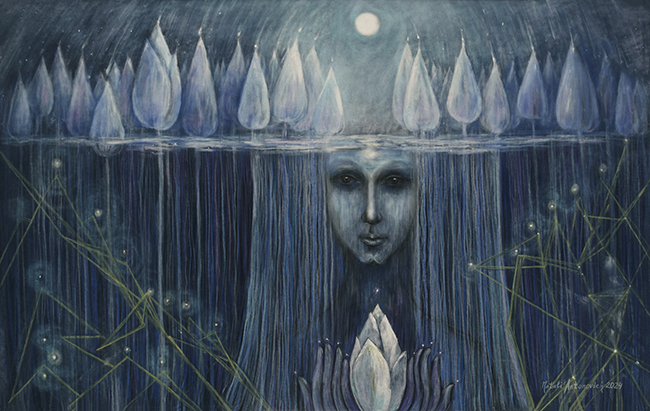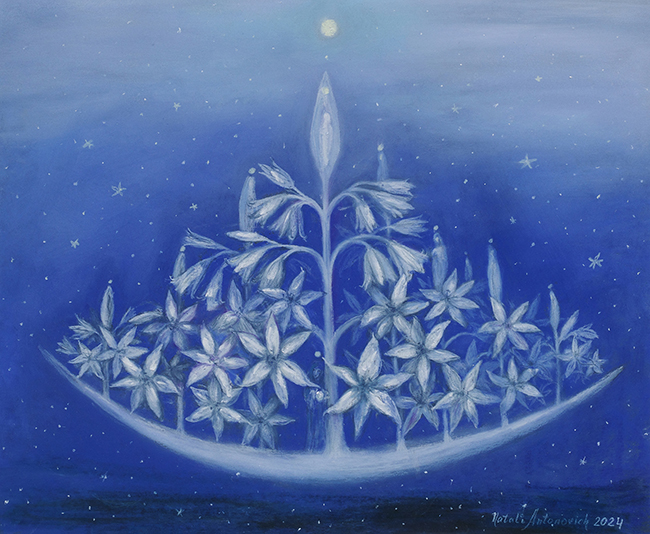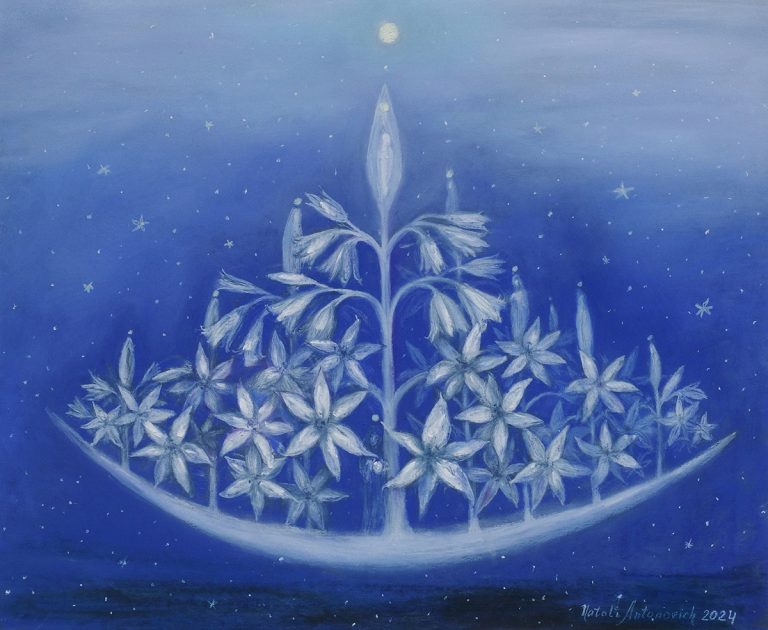There’s something almost otherworldly about the art of Natali Antonovich. Her work acts as a portal—quiet, luminous, and deeply personal. She doesn’t just paint what she sees; she paints what she feels, what she questions, and what she hopes to understand. For Antonovich, the creative process is a dialogue with herself, a way to navigate the often unspoken layers of emotion and meaning that define human experience. Her art emerges from contemplation rather than impulse, from stillness rather than noise.
Antonovich has always been an observer. Even in early life, she noticed the details that others might overlook—the subtleties of shadow, the quiet rhythm of seasons, the way light reveals truth in unexpected places. This inclination to reflect and observe never left her; it has become the essence of her practice. Through her paintings, she turns inward, yet her works invite others in—offering a glimpse into a world where emotion, symbolism, and spirit intertwine.

The Power Is in You (2024)
In The Power Is in You, Antonovich presents a serene yet compelling vision of inner strength. The composition radiates calm, rendered in soft gradients of blue and white, as if bathed in the light of dawn. At first glance, it feels celestial—like a dream suspended in still air. But beneath the quiet, there’s tension: a subtle pulse that speaks of awakening and potential.
The piece features an intricate arrangement of flowers growing from a luminous arc—a cradle of energy rising from the void. Each bloom seems to reach for something unseen, suggesting growth, faith, and persistence. The moon above, faint and watchful, acts as both guide and witness. It is a symbol of intuition, of cycles that repeat and renew.
Antonovich’s pastel technique adds to the work’s sense of softness and grace. The medium allows her to blend edges until forms feel like they’re breathing. Her palette is limited but purposeful, each tone chosen not for contrast but for harmony. The result is a painting that feels alive in its quietude—a meditation on resilience.
The title, The Power Is in You, speaks to her philosophy. Strength, in Antonovich’s world, is not loud or forceful; it is gentle, steady, and rooted in trust. The artwork suggests that self-discovery is not an external pursuit but an inward journey. Like the flowers that bloom from the crescent base, we grow from within, guided by something invisible yet profoundly real.
The Twenty-Sixth Crown (2024)

The Twenty-Sixth Crown shifts tone and depth but remains unmistakably hers. It’s moodier, denser—like descending into the subconscious. The painting is divided between two worlds: the surface, marked by delicate buds bathed in moonlight, and the depths below, where a face emerges from flowing blue shadows. This duality—above and below, seen and unseen—is a recurring theme in Antonovich’s work.
Here, the central figure seems to be both human and elemental, as if the spirit of water itself had taken form. The eyes are calm but penetrating, watching from beneath the veil of rippling lines. Above, the buds resemble silent sentinels, waiting to bloom. Below, the figure holds a single open flower close to the chest—a gesture of reverence or surrender.
The painting’s title, The Twenty-Sixth Crown, carries a sense of ritual or ascension. There’s something spiritual in the numbering—a suggestion that each crown, each stage, represents a step toward awakening or understanding. The use of light reinforces this narrative. The moon is not merely illumination; it’s a beacon, a source of quiet authority. The entire scene feels like a sacred moment unfolding underwater, beyond language or time.
Technically, Antonovich demonstrates a remarkable control of mood through layering. Her use of pastel on paper allows for both translucency and density. She builds her forms gradually, letting textures suggest movement—like the slow current of water carrying memory. Every stroke feels deliberate, every glow intentional.
Emotionally, The Twenty-Sixth Crown is about surrendering to what lies beneath the surface. It asks the viewer to acknowledge the unseen parts of the self—the hidden thoughts, the buried hopes, the quiet wisdom that lives in stillness. While The Power Is in You looks upward toward light, The Twenty-Sixth Crown turns inward, seeking truth in darkness.
A Language of Stillness
Together, these two works reveal the duality that defines Antonovich’s art: the balance between ascent and introspection, between cosmic and personal. Her world is not one of chaos or noise but of careful listening. She paints not to explain but to explore—to make visible what often stays hidden.
In an age of constant distraction, Antonovich’s art feels like a pause. It reminds us that meaning often resides in quiet places. Through her delicate lines and restrained color, she creates a kind of visual poetry—one that asks not for applause, but for reflection. Her paintings, soft-spoken as they are, leave a deep echo. They speak of endurance, of mystery, and of the quiet power that lives within us all.

